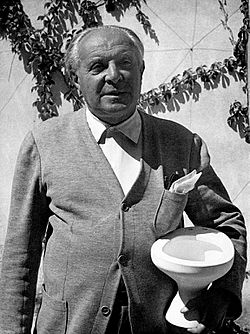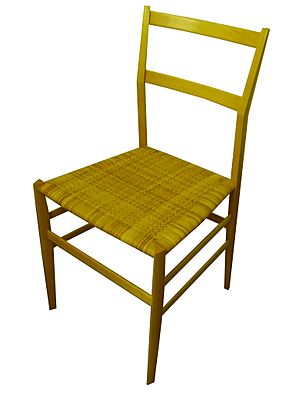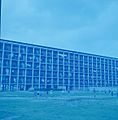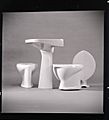Gio Ponti facts for kids
Quick facts for kids
Gio Ponti
|
|
|---|---|
 |
|
| Born | 18 November 1891 Milan, Italy
|
| Died | 16 September 1979 (aged 87) Milan, Italy
|
| Alma mater | Politecnico di Milano |
| Occupation | Architect |
| Buildings | Pirelli Tower, Milan; Concattedrale Gran Madre di Dio, Taranto; Villa Planchard, Caracas; Denver Art Museum, Denver, CO (with James Sudler Assoc.); Palazzo Montecatini, Milan. |
Giovanni "Gio" Ponti (born November 18, 1891 – died September 16, 1979) was a famous Italian architect and designer. He was also a furniture designer, artist, teacher, writer, and publisher.
Gio Ponti worked for over sixty years. He designed more than a hundred buildings in Italy and around the world. He also created many beautiful art objects and pieces of furniture.
Ponti started a magazine called Domus in 1928. He led it for most of his life. Through Domus and his work in exhibitions, he helped share Italian design with the world. He played a big part in bringing new ideas to Italian design after World War II.
From 1936 to 1961, he taught at the Milan Polytechnic School. He helped train many future designers. Ponti also helped create the Compasso d'Oro prize in 1954. This is one of the most important design awards.
His most famous works include the Pirelli Tower in Milan. It was built from 1956 to 1960 with engineer Pier Luigi Nervi. Other well-known designs are the Villa Planchart in Caracas and the Superleggera chair. The Superleggera chair was made by Cassina in 1957.
Contents
Early Life and Education
Gio Ponti was born in Milan, Italy, in 1891. His parents were Enrico Ponti and Giovanna Rigone. His studies were paused when he served in the military during World War I. He was a Captain from 1916 to 1918. He received awards for his bravery.
Ponti finished his architecture degree in 1921. He studied at the Politecnico di Milano University. In the same year, he married Giulia Vimercati. They had four children: Lisa, Giovanna, Letizia, and Giulio. They also had eight grandchildren.
Designing Buildings and Interiors

Ponti started his architecture career in 1923. He worked with partners like Mino Fiocchi and Emilio Lancia. At first, he was influenced by a style called Novecento Italiano. In 1925, he showed his work at an exhibition in Paris. There, he met Tony Bouilhet, who later gave him his first building project outside Italy.
This project was a country house near Paris called Ange Volant (1926–1928). Around the same time, he built his first building in Milan. These projects helped Ponti develop his ideas for an "Italian-style house." He wrote about these ideas in his 1933 book, La Casa all'Italiana.
Modern Designs in Milan
In the 1930s, Ponti was very busy, especially in his hometown of Milan. He started to use a more modern style. He removed extra decorations and focused on simple shapes. His goal was to make the style and structure of a building work together.
He built ten "typical houses" in Milan between 1931 and 1938. These houses were close to modern styles but still had Mediterranean features. They included balconies, terraces, and pergolas. These homes were spacious and used modern materials. They were perfect for the new wealthy families in Milan.
Ponti also designed the first office building for the Montecatini chemical group (1935–1938). He used the newest building techniques and materials. This showed the company's modern spirit. He designed every detail of this large building, from its architecture to its furniture.
Famous Towers and Universities
For the 1933 Fifth Triennial of Decorative Arts in Milan, Ponti designed a steel tower. It was called the Littoria Tower, now known as the Branca Tower. It was 108 meters (354 feet) tall and had a restaurant at the top.
Ponti also helped design the new university campus in Rome. He created the School of Mathematics, which opened in 1935. He made bright, useful spaces with simple lines. One building was shaped like a fan and held three lecture halls.
He worked at the University of Padua from 1934 to 1942. He designed the new Faculty of Arts, Il Liviano. He also oversaw the artistic design of the main hall and other parts of the Palazzo Bo.
After World War II
After World War II, Italy's economy grew quickly. The 1950s were a very busy time for Ponti. He traveled a lot and worked on many projects. He helped redesign the interiors of several Italian ocean liners. These ships showed off Italy's design skills to the world.
In 1952, he opened a new design office in Milan. It was like a big lab for architecture. He also designed a nine-story apartment building in Milan where his family lived.

One of his most famous projects was the Pirelli Tower (1956–1960). He worked with engineer Pier Luigi Nervi. This 31-story skyscraper in Milan was 127 meters (417 feet) tall. For a short time, it was the tallest building in Europe. It changed Milan's skyline.
International Projects
Ponti became famous around the world. He received many projects in places like Venezuela, Sweden, and Iraq. In New York City, he designed the Alitalia airline office on Fifth Avenue. He also designed an auditorium in the Time-Life building.
In Caracas, Venezuela, Ponti created one of his masterpieces: the Villa Planchart (1953–1957). This house was designed like a work of art. It was built on a hillside with a tropical garden. The villa felt very light and open. It was even called the "butterfly house." All the furniture and materials were sent from Italy.
In the 1960s and 1970s, Ponti worked on many international projects. He designed buildings in Tehran, Islamabad, and Hong Kong. He made building fronts lighter, almost like hanging screens. He also used ceramics a lot, both inside and outside his buildings. He created diamond-shaped tiles that covered many of his building facades.
His designs became more transparent and light. He saw building fronts as folded paper with geometric shapes. In 1970, the Taranto Cathedral opened. It was a white rectangular building with a huge concrete front that looked like a "sail." In 1971, he helped design the exterior of the Denver Art Museum in Colorado.
Designing Everyday Objects
In 1923, Ponti became the artistic director for Richard Ginori. This was a leading porcelain company in Italy. He completely changed their designs. He updated classic styles and made the production process more efficient. His new designs won a major award in Paris in 1925.
Ponti played a big role in modernizing Italian decorative arts. He worked with many companies. These included Christofle for silverware and Venini and Fontana Arte for glass. He also started the Labirinto group, which made unique furniture from fancy materials. At the same time, he designed simpler, mass-produced furniture for department stores.

In the 1930s, Ponti continued to design unique furniture. But he also pushed for good quality, mass-produced items. He designed furniture and lighting for Fontana Arte. He became their artistic director in 1933. He created the famous Bilia Lamp.
After the 1940s, Ponti focused on special creations. These showed off the skills of amazing craftspeople. He worked with artist Paolo De Poli to create colorful enameled panels and furniture. He also designed many glass objects for the Venini glass factory. These included bottles that looked like stylish female bodies.
Iconic Furniture and More
From 1940, he worked with designer Piero Fornasetti. They created furniture and interiors with lots of decoration and imagination. Their work included designs for the Palazzo del Bo in Padua and the Sanremo Casino.
In the 1950s, Ponti created many useful and beautiful designs. He designed an espresso machine for La Pavoni and a sewing machine for Visa. He also designed textiles, door handles, bathroom fixtures, and cutlery.
His work with Cassina led to classic Italian designs. These include the Leggera and Superleggera chairs. The Superleggera chair, designed in 1957, is still made today. Ponti made it super light, weighing only 1.7 kg (3.7 pounds). It was so light that a child could lift it with one finger. Yet, it was very strong.
Ponti continued to create new designs in the 1960s. These included armchairs for Knoll International and Poltrona Frau. He also invented lighting fixtures for companies like Artemide.
In 1970, Ponti showed his idea for an "adapted house." This house had a large main room with sliding walls. This allowed the space to be changed easily. Furniture was flexible and saved space. His Gabriela chair (1971) and Apta furniture series (1970) showed this new way of living.
Ponti also designed wall and floor tiles that were like works of art. He created colorful, geometric tiles for Ceramica D'Agostino. These were used in places like the Salzburger Nachrichten newspaper headquarters in Salzburg. He passed away on September 16, 1979.
Sharing His Ideas
From the start of his career, Ponti promoted Italian creativity. He believed Italians were born to build and create. He wrote that building was a key part of their history and identity.
He became involved with the Monza Biennials, which were art and design exhibitions. He pushed for closer ties between crafts and industry. Thanks to his efforts, the Biennials grew a lot. They moved to Milan in 1933 and became the Triennials. These events became important places to see new ideas from around the world.
Domus Magazine
Ponti founded the Domus magazine in 1928. He led it for almost his entire life. This magazine was about art, architecture, and interior design. It allowed him to share his ideas widely. The magazine aimed to show all kinds of art. It also introduced Italian readers to modern designers like Le Corbusier and Charles Eames.
Domus became more international over time. It played a big role in how Italian and global design and architecture developed. Even today, Domus is a very important magazine in these fields.
For a few years, from 1941 to 1947, Ponti edited another magazine called Stile. After World War II, he returned to Domus. His daughter, Lisa Licitra Ponti, later joined the editorial team. In the 1950s, Domus became even more international. It helped spread "Made in Italy" design around the world.
In 1957, Ponti published his important book, Amate l'architettura (In Praise of Architecture). In it, he described his idea of a "finished form." This was a simple, light design that couldn't be added to or changed. He often used the hexagonal shape of a diamond to show this idea in his work.
Ponti organized many events in Italy and other countries. In 1964, he held exhibitions in Milan called "Espressioni." These showed the work of new talents like Achille and Pier Giacomo Castiglioni. He also became friends with art critic Pierre Restany, who wrote for Domus.
From 1936 to 1961, he was a professor at the Politecnico di Milano University. He taught architecture students.
Awards and Recognition
Ponti received many honors for his work. In 1934, he was given the title of "Commander" of the Royal Order of Vasa in Stockholm. He also won the Accademia d'Italia Art Prize. He received a gold medal from the Paris Académie d'Architecture. He was also given an honorary doctorate from the London Royal College of Art.
Images for kids
-
Pirelli Tower, Milan (1956–1961), interior
-
Dessert spoon and fork (Sabattini); photo 1963.
See also
 In Spanish: Gio Ponti para niños
In Spanish: Gio Ponti para niños









